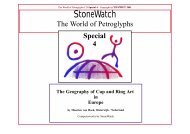petroglyphen im valle del encanto - StoneWatch
petroglyphen im valle del encanto - StoneWatch
petroglyphen im valle del encanto - StoneWatch
Sie wollen auch ein ePaper? Erhöhen Sie die Reichweite Ihrer Titel.
YUMPU macht aus Druck-PDFs automatisch weboptimierte ePaper, die Google liebt.
her the multiple cup-and-rings featuring many radial grooves,<br />
often creating a (solar ?) wheel-like <strong>im</strong>pression, are later, or<br />
those radials are later additions. Indeed, there are instances<br />
where the secondary character of radial grooves is evident. For<br />
instance, subsequent radials are often carved superficially<br />
across the rings without touching the deepest points (Photo 6).<br />
Photo 6. Detail of two twinned multiple rings on the sandstone outcrop<br />
ridge at Buttony 4, Northumberland, England, now overgrown. Notice<br />
the original radial grooves running down slope and the more superficially<br />
engraved radials, two in the left figure and one faint one in the<br />
right figure. Diameter of the bigger device to the right is 52 cm.<br />
A variant of the radial groove is the so-called keyhole pattern<br />
(Photo 7). As this motif is not represented in passage grave art<br />
as well, it is also ascribed to the Late Neolithic. I know only of<br />
one keyhole motif within a tomb, the Dolmen de Soto, SW<br />
Spain, where an unweathered keyhole occurs as a single motif<br />
at the centre of an orthostat. It contrasts strongly with much<br />
worn cupules elsewhere in the tomb, some carved at almost<br />
inaccessible places. The burial mound dates around 2.000 BC,<br />
confirming a later date for the keyhole.<br />
Photo 7. Detail of a perfect keyhole design on the smooth greywacke<br />
outcrop at Townhead 3D, Galloway, southern Scotland. Notice that the<br />
central cupule actually consists of a natural depression, a feature relatively<br />
common in Galloway and Eastern Ireland. Diameter of the outer<br />
ring is 35 cm.<br />
Another argument for a later appearance is the phenomenon of<br />
the degraded keyhole. It proves that notably many keyhole<br />
motifs in fact consist of earlier cup-and-rings, where two or<br />
more parallel grooves have been added to form a keyhole pattern,<br />
in some cases rather clumsily. Classical examples are<br />
found at the outcrop at Boheh, a solitary site at the west coast of<br />
Ireland where a mixture of at least 24 true and degraded keyholes<br />
is found, depicting a sort of evolution of the keyhole pattern.<br />
Also at Carschenna, Switzerland, some radial grooves and deg-<br />
10<br />
raded keyholes are found. The best example (Photo 8) is found<br />
at Rock II. From an extremely small central cupule, surrounded<br />
by three concentric rings, runs a fainter radial groove. Almost<br />
touching the outer ring is a pair of cru<strong>del</strong>y carved, parallel grooves<br />
that have been added to the motif to form a degraded keyhole<br />
figure.<br />
Photo 8.<br />
Detail of the degraded keyhole on the sandstone outcrop escarpment at<br />
Carschenna II, Graubünden, Switzerland. Notice the difference in groove<br />
d<strong>im</strong>ensions between the ringmarks, the faint radial groove and the bold<br />
keyhole grooves. Such bold grooves are a distinctly later feature at a number<br />
of the rocks at Carschenna. Diameter of the outer ring is 16 cm.<br />
Recently Jorge Díaz Sánchez cla<strong>im</strong>ed that the cup-and-ring with<br />
radial groove possibly depicted the legendary city of Atlantis,<br />
but I rather suggest that it is a symbol with a magical meaning,<br />
related to the belief in after death in a changing cultural context.<br />
After the period of the <strong>im</strong>pressive communal passage tombs a<br />
more individual conception of life was introduced, which was<br />
possibly reflected as well by the introduction of the radial groove<br />
breaking through the circle, s<strong>im</strong>ultaneously breaking down<br />
its old magic. In Africa there are petroforms, resembling the cup<br />
and ring with radial groove and there it means that an individual<br />
had „gone home“. Most likely also the radial groove in cupand-ring<br />
art symbolized a spiritual path of the individual into the<br />
supernatural world.
















